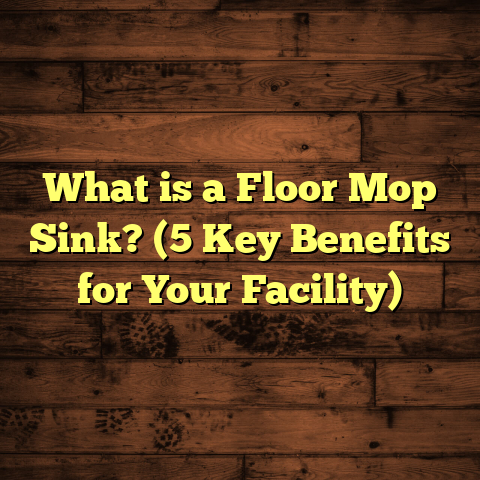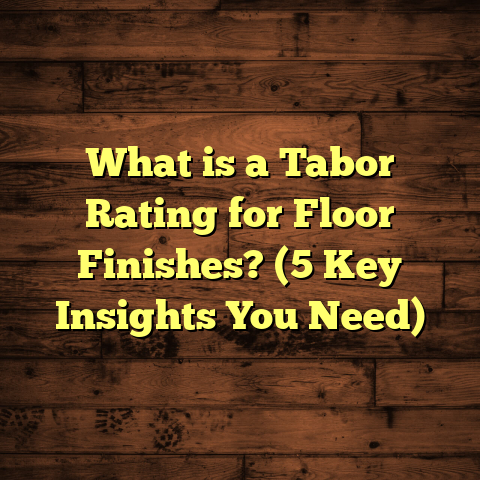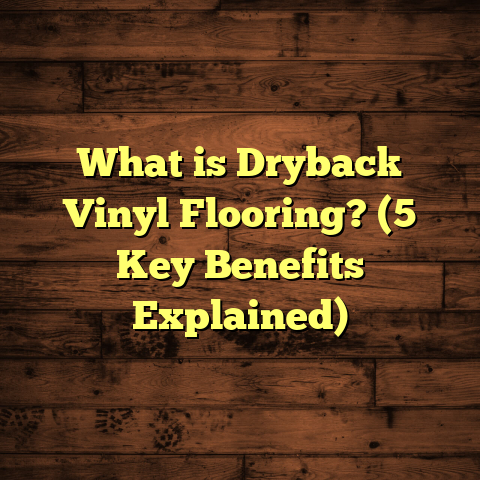What is Hardwood Flooring Made Of? (5 Key Materials Explained)
Hardwood flooring is more than just a surface beneath your feet — it’s a story of nature, craftsmanship, and history all rolled into one. When I first started working with hardwood floors over a decade ago, I quickly found that understanding what these floors are made of is key to appreciating their beauty and durability. Over time, I’ve learned that hardwood floors are complex systems composed of various materials that interact together to create stunning, long-lasting floors.
Whether you’re a homeowner considering new flooring or a contractor like me who installs them regularly, knowing the makeup of hardwood flooring helps you make smarter decisions. So, let’s talk about what hardwood flooring really is and what materials go into it.
What Is Hardwood Flooring Made Of?
At its core, hardwood flooring is made from wood sourced from trees classified as hardwood species. But beyond that simple definition, hardwood floors consist of several fundamental materials that influence their strength, appearance, durability, and maintenance needs.
Hardwood flooring can be broadly divided into two types based on construction: solid hardwood and engineered hardwood. Each type involves different materials and layers.
I want to walk you through the five main materials that make up hardwood flooring, what they do, and why they matter.
1. Solid Wood: The Heart of Hardwood Floors
Solid wood is exactly what it sounds like — planks cut entirely from a single piece of wood. These planks come from hardwood trees such as oak, maple, cherry, hickory, walnut, ash, and more.
Why Solid Wood?
When I first started installing floors, I was amazed at how each wood species has its own personality. Oak, for instance, has a coarse grain with swirls that create a classic look. Maple is smooth and pale with tight grain patterns. Walnut brings rich chocolate tones with dramatic streaks.
Solid wood provides:
- Durability: Depending on the species, solid wood can stand up to heavy foot traffic.
- Refinishability: Because it’s thick (usually ¾ inch), solid wood floors can be sanded and refinished multiple times over decades.
- Longevity: Many solid wood floors last 50 years or more when cared for properly.
Challenges with Solid Wood
Despite all these benefits, solid wood has challenges. The biggest one is its sensitivity to moisture and temperature changes. Wood naturally expands or contracts with shifts in humidity levels. This can cause:
- Gaps between planks during dry seasons
- Cupping or crowning when moisture levels are high
- Buckling if moisture gets trapped underneath
Early in my career, I learned this the hard way on a project where the wood wasn’t acclimated enough before installation. The planks shrank significantly after installation, leaving visible gaps that upset the homeowner.
Acclimation Is Key
To prevent these issues, solid hardwood must be acclimated on site for at least 3-7 days before installation. This gives the wood time to adjust to the room’s temperature and humidity.
Also, maintaining indoor humidity between 35%-55% year-round keeps the floor stable. I always recommend clients invest in humidifiers or dehumidifiers as needed.
Popular Solid Wood Species and Their Characteristics
Let me share some data on popular species based on my experience and industry reports:
| Species | Janka Hardness (lbs) | Color Range | Grain Pattern | Durability | Typical Use |
|---|---|---|---|---|---|
| Oak (Red/White) | 1,290 – 1,360 | Light to medium brown | Prominent grain | Highly durable | Living rooms, hallways |
| Maple | 1,450 | Creamy white to light brown | Fine grain | Very durable | Kitchens, modern spaces |
| Hickory | 1,820 | Varied (light to dark) | Bold grain | Extremely tough | High-traffic areas |
| Walnut | 1,010 | Rich dark brown to purples | Straight to wavy grain | Moderate durability | Bedrooms, formal rooms |
| Cherry | 950 | Reddish brown that darkens over time | Smooth grain | Moderate durability | Elegant interiors |
This table shows just how different each species is not only in looks but performance too.
2. Engineered Wood Layers: Stability Meets Real Wood
If solid wood is one layer all the way through, engineered hardwood consists of multiple layers bonded together under heat and pressure.
The top layer is a thin slice (veneer) of real hardwood — usually between 0.6 mm to 6 mm thick — that provides the authentic wood look. Below that are several layers of plywood or high-density fiberboard (HDF) arranged crosswise for strength.
Why Engineered?
Engineered hardwood was developed to address some of the problems with solid wood floors:
- Moisture Resistance: The layered construction reduces expansion and contraction.
- Installation Flexibility: Can be installed over concrete slabs or radiant heating systems.
- Cost Efficiency: Sometimes less expensive than thick solid wood while still offering genuine wood surface.
In my experience installing floors in basements or kitchens where moisture levels fluctuate more, engineered hardwood performs much better than solid wood.
Layer Details
The core layers often use plywood or HDF:
- Plywood Core: Multiple thin layers of wood glued at alternating grain directions. This adds strength and stability.
- HDF Core: Compressed wood fibers with adhesives for a very dense core.
The combination of these layers results in dimensional stability that solid wood can’t match.
Thickness Matters
The veneer thickness affects how many times the floor can be sanded and refinished. Thicker veneers (over 3 mm) allow for one or two refinishes; thinner veneers may not allow refinishing at all.
When advising customers, I always explain veneer thickness clearly because it impacts long-term maintenance plans.
3. Finishes and Sealants: Protecting and Beautifying Hardwood
Raw wood needs protection — otherwise it would stain easily, scratch quickly, and degrade fast.
Finishes form the protective barrier on top of hardwood floors while enhancing color and shine.
Types of Finishes
Here are the main finish types I work with:
- Oil-Based Polyurethane: Provides a durable surface with an amber tone that deepens wood color. It takes longer to dry and emits strong odors during application.
- Water-Based Polyurethane: Dries faster with low odor and clear finish but usually less durable than oil-based.
- Aluminum Oxide Coatings: Extremely tough finish often factory-applied on prefinished flooring.
- Natural Oils (e.g., Tung Oil): Penetrate wood for a natural look but require more frequent reapplication.
- Wax Finishes: Rarely used today due to maintenance needs but provide a soft matte surface.
Finish Pros & Cons from My Work
For high-traffic commercial projects, I usually recommend aluminum oxide finishes for their scratch resistance.
For residential spaces where homeowners want natural warmth and are willing to do occasional upkeep, oil finishes work beautifully.
Choosing finishes means balancing durability needs against aesthetics and maintenance willingness.
Common Issues
I’ve encountered several finish-related challenges in my career:
- Premature finish wear due to improper curing time.
- Yellowing of oil-based finishes in UV-exposed rooms.
- Difficulties repairing scratches on factory-finished floors without sanding whole areas.
These experiences taught me how critical finish choice and application technique are for long-lasting floors.
4. Adhesives and Fasteners: Keeping Floors Secure
Hardwood flooring doesn’t just lie on the subfloor; it needs secure attachment for stability and longevity.
Depending on the installation type — nail-down, glue-down, or floating — different adhesives or fasteners come into play.
Nail-Down Method
Used mainly with solid hardwood over wooden subfloors. Nails or staples are driven through the plank edges at an angle.
Pros:
- Strong mechanical bond
- Allows floor movement with seasonal changes
Cons:
- Requires wooden subfloor
- Can cause squeaks if nails loosen over time
Glue-Down Method
Planks are glued directly to concrete or plywood subfloor using specialized adhesives.
Pros:
- Suitable for concrete slabs
- Provides firm support reducing hollow sounds
Cons:
- Difficult to remove once glued
- Requires precise adhesive application
Floating Floors
Popular with engineered hardwood; planks lock together but aren’t attached to subfloor with nails or glue.
Pros:
- Quick installation
- Allows for expansion/contraction
Cons:
- Can feel less solid underfoot
- Susceptible to shifting if not installed properly
Adhesive Advances
Modern adhesives have improved dramatically with lower volatile organic compounds (VOCs) for healthier indoor air quality. They also offer stronger bonds with flexible properties to accommodate floor movement.
I once had a project where poor adhesive choice led to boards lifting weeks after installation — a costly fix that reinforced my attention to product selection.
5. Subfloor Materials: The Foundation Beneath It All
The subfloor is not part of the visible hardwood but is critical for performance. It provides the flat surface on which hardwood planks rest or attach.
Most common subfloor materials are:
- Plywood: Thin layers of wood veneer glued at right angles for strength.
- Oriented Strand Board (OSB): Compressed wood strands bonded into panels; cheaper than plywood but less water-resistant.
- Concrete: Used in basements or slab foundations; requires moisture barriers for hardwood installation.
Uneven or damaged subfloors can cause creaking floors or uneven wear patterns over time. Before any install, I always inspect subfloors carefully and repair or level as needed.
Moisture Barriers & Underlayment
When installing over concrete or in areas prone to moisture, vapor barriers like polyethylene sheets help prevent water vapor migration up into the wood.
Underlayment materials can also provide sound insulation and cushioning beneath floating floors.
My Hardwood Flooring Successes and Challenges
Over the years working with hardwood floors in various homes and commercial spaces, I’ve encountered countless examples illustrating both the beauty and complexity of this material.
A Restoration Triumph
One unforgettable project was restoring the floors of a historic Victorian home built in 1890. The original oak planks were worn but salvageable. We sourced reclaimed oak boards from period-correct lumber yards to patch damaged areas seamlessly.
Watching those floors come back to life taught me how durable solid wood is when cared for properly — some planks were over 130 years old!
Moisture Mishap Lesson
On another job in a coastal city with high humidity swings, solid oak floors installed without adequate acclimation cupped badly within weeks. The client was frustrated by visible gaps forming between boards during dry spells.
That experience pushed me to always emphasize acclimation protocols and moisture control devices to clients—lessons worth their weight in gold when it comes to avoiding callbacks.
Engineered Wood Saves the Day
I recall a basement renovation where engineered maple flooring installed over a concrete slab performed flawlessly while nearby solid wood floors upstairs showed seasonal movement issues.
This reinforced my confidence recommending engineered hardwood where moisture risk exists without sacrificing real wood aesthetics.
Data Insights & Industry Trends Backing Hardwood Materials
Looking at data helps put these materials into perspective:
- According to Wood Floor Business magazine’s latest reports:
- Solid hardwood still accounts for about 60% of residential installations.
- Engineered hardwood installations have grown by nearly 15% annually over the last decade.
- The global hardwood flooring market is valued at approximately $15 billion as of recent estimates.
- The Janka hardness rating system guides material selection by measuring resistance to denting:
- Softwoods like pine rate around 380 lbs.
- Popular hardwoods range between 900 lbs (cherry) up to 1800 lbs (hickory).
- Finish longevity varies by type:
- Aluminum oxide factory finishes last up to 30 years before refinishing.
- Oil-based polyurethane requires recoating every 7-10 years.
These stats reflect why understanding material properties matters so much during planning and installation stages.
How I Use Tools Like FloorTally in My Flooring Projects
Estimating costs accurately has always been one of my biggest challenges — especially when juggling multiple projects in different cities with varying labor rates and material prices.
Using FloorTally has changed how I handle this task. It lets me input project dimensions along with local material costs and labor rates to generate detailed cost estimates quickly. This saves hours compared to calling suppliers individually or using manual spreadsheets.
One feature I appreciate is the waste factor calculator — it accounts for extra material needed due to cutting waste or defects which many forget until they run short mid-project.
For example, on a kitchen remodel covering 350 sq ft with engineered walnut flooring last month, FloorTally helped me provide the client with a transparent cost breakdown upfront — including installation labor, materials, finishes, and even removal of old flooring.
This level of detail builds trust and streamlines budgeting conversations enormously.
Final Thoughts on Hardwood Flooring Materials
Choosing hardwood flooring means understanding its composition and how each material contributes to its overall performance. Solid wood offers timeless beauty but requires careful moisture management. Engineered wood blends stability with real wood aesthetics ideal for challenging environments. Finishes protect while influencing maintenance efforts. Adhesives secure floors but must be chosen wisely. And the subfloor forms an often overlooked foundation critical for success.
Have you ever noticed your hardwood floor changing shape or color? Maybe it’s worth checking what kind of material you have underfoot — sometimes those details explain why your floor behaves a certain way.
If you’re thinking about installing hardwood flooring yourself or hiring someone like me, knowing these materials helps you ask the right questions and get floors you’ll love for decades ahead.
Feel free to ask if you want tips on choosing species or finishes based on your lifestyle — I’m happy to share what I’ve learned over countless projects!





